As the sun was setting behind us we saw the Grand Island Camp Ground in front of us. We luffed the sails and glided into an old-style wood and concrete ferry dock. My father Bill, and I were totally worn out and wet from a day of beating into the wind. Serendipity had not performed as well as I had hoped. We disembarked with sore limbs and walked up into the center of the camp for a much-needed fresh water rinse at the outdoor showers. From the showers we could see the breakers rolling in from the Atlantic on the ocean side of the Outer Banks. Bathed, we walked back to the boat and made camp on the bridge deck of my catamaran.
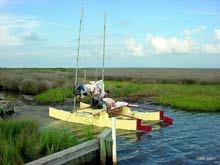 |
Grand Isle the morning after |
The skeeters were already making their presence known so I pushed through the shallows, away from the reeds and mud into slightly deeper water and dropped anchor. Moving away from the dock also got us out of the way of the ferry when it arrived first thing in the morning.
In the dark, I lay down to write in my log and thought briefly of the previous nights camping site, a beach just short of Cape Lookout on the ocean side of Shackleford. We had enjoyed wild horses running on the shore and a well-deserved sip of bourbon.
This picture on the home page of www.obx130.com comes from that evening. |
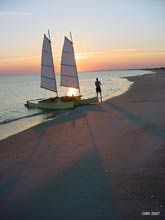 |
Our day started with us sailing over to the lighthouse on Cape Lookout. We got there as the visitors office opened. The sand was gleaming white and the water mellow. The sun had risen behind the lighthouse and the birds were out in force screeching and scavenging the nights spoils left with the falling tide. This stop at the visitors’ center was for one purpose, an Outer Banks camping permit. After getting the permit we took advantage of the public restrooms as the first ferry arrived to drop people off who wanted to spend the day on the beach. I can still see the appeal for the day visitors; the ocean side of Cape Lookout is truly one of the nicest beaches I have been to in the States. With everything squared away we raised anchor, set our sails, and headed up Drum Inlet into the eye of the wind. Lots of tacking was ahead of us. I had been optimistic that my boat would fair well in these conditions. This was the third summer I had taken Serendipity out and in all of my outings it had performed better than expected. On one downwind run the summer before we had hit 7.5 knots. It was great to get my little 16' home-built catamaran and my poly-tarp sails up to such speeds. This was the first day I would spend trying to beat to windward for a whole day. We had started that morning trying to get up to Long Point camp, perhaps even Silver Lake. If we had been traveling downwind we would have easily made it to Silver Lake.
If we had been sailing with the winds at our back without tacking we would have sailed in a straight line 14.5 miles that day. If you look at the wind rose for July, it predicted we should have had following winds, on average. But it was not to be, and averages are no guarantee. It should have taken 4 hours to travel that straight line but it took us 11 hours to sail into the wind, and probably 25 extra miles of tacking. As we beat into the wind we had starting noticing that the best we could point into the wind was 40 degrees. If you look at the past articles I wrote about building Serendipity you will notice that I made the sails myself. The designer of this boat, Jeff Gilbert, said that no draft should be needed in these sails. As we tried to point into the wind we got more and more discouraged. We cut our expectations short and pulled into the Grand Isle camp that night, exhausted and sore. We had decided that Serendipity probably needed some draft in those sails.
So, as I lay there that night thinking about my boat, I felt badly for giving her a set of sails that did not let the designs true nature shine. We initially had planned on sailing up to Pamlico Sound for a day and then heading back to Cape Lookout. When we woke the next morning and the wind was the same, we decided to cut that stop out of our trip and head to the east side of Harker’s Island Nature Preserve a day early. It took us 3 hours to sail going downwind and she was flying! Taking the swell and swimming straight down the inlet. It was very nice to feel Serendipity racing again, the way she should. We had prearranged that at Harker’s we would do a crew swap. Bill would depart and my brother Sean would join me. We got to Harker’s and pulled into the small beach, again near a ferry that runs to Cape Lookout. It was a beautiful day and the wind was blowing in the high teens.
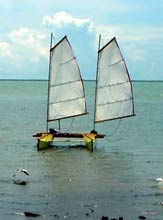 |
Anchored at Harker’s Island for the crew change |
With my brother Sean as my new crew we headed back down to Cape Lookout with the ferry and other motorboats all waving to us as they passed, at least they were friendly while they left their wakes! It was a pleasure to have Sean aboard. He cast a fishing line behind us. We were not properly trolling and I did not think we would actually catch anything. On this trip I had seen dolphins, large sea turtles, marlin jumping, a plethora of unnamed fish, and hundreds of different kinds of birds. The whole area is known as a wildlife and bird sanctuary unlike anything else on the east coast. The range of barrier islands that are uninhabited, except for wildlife, is amazing. And since they are all surrounded by shallow water, only boats with shallow drafts can camp and explore these places. But I digress. So, I wasn't expecting to catch anything while we were crossing the bight of Cape Lookout to camp for the night. But then something big and strong hit the line. It looked something like a Bonito. I cleaned it, cut it up and mixed it into some yellow rice concoction. It didn't really taste like anything but it was satisfying. We nestled into our sleeping bags that night right next to a 19th century shipwreck.
| Sean at Cape Lookout |
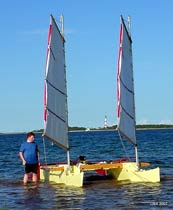 |
The next morning we walked across the island to the outer beach facing the Atlantic. The rollers were big and you can tell that the barrier islands really do a great job or protecting the waters inside. I have sailed on the outside many times and don't have any problems launching through the occasional massive surf you have to get through. But it takes courage and practice to get out when the sea is up. So, in planning the OBX130 I have made the conscious choice to have the course all on "the Inside."
When we got back to the boat we passed the wreck and found a very large anchor at low tide in about 4 feet of water. It was massive. It was evidence of yet another boat wrecking in these waters, even with the protection of the bight. The hurricanes in these parts are not forgiving. Just look up shipwrecks of North Carolina on Google sometime. The bone yard of the Atlantic is so called for a reason. Snorkel gear is always a good thing to bring along in these waters.
We sailed back to Atlantic Beach where my family had a house they were renting and pulled up onto the beach. Time for a shower and a real bed! The next day Bill and I sailed out to the backside of Shackleford Island for one more night out in the wilderness. We found a secluded little beach and camped the night there.
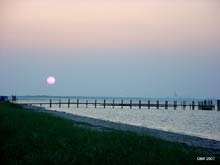 |
Sunset on the backside of Shackleford Island |
In the morning we were woken by a thundering sound. It was almost as if we were about to be stampeded by…… HORSES! It jolted me out of the tent well before dawn, my dear old dad managed to stay in his sleeping bag. I enjoyed the horses running down the beach playing as the sun came up. They were running for the fun of it as fast as they could, playing and wrestling as the sun rose higher. It was a glorious end to a beautiful small boat adventure.
The next summer Bill and I participated in our first structured event, the Texas200, and you can see his account of that adventure here and here. I had originally built my first Lars Boat, and then Serendipity, to compete in the Everglades Challenge. I never did it for a variety of reason. But the Texas200 had really inspired me. Some of the things that I like the most about the Texas200 were, in no particular order;
1) Meeting so many people I had only encountered on the Internet. It is not too often you meet that rare breed of insanity that makes one build their own boat, and sail it on their own.
2) Talking to these people about the geeky things we love. We all got along splendidly. I remember a particularly great night at Paul's Mott where everyone had a few drinks and chatted about boats, stars, and sailing. (And how much crazier than us the Puddleduck sailors are.)
3) Ending each day at the same place, sailing during the day, and passing the other boats. I sense this doesn't really happen on the EC. It seems more "every-person for themselves." I like being part of a group. The radio chatter was fun and informative every day.
4) Camping on a boat in the few wilds we have left in the US is important to me. I am glad I got the chance to see this part of Texas. The Dolphins were out in force on day 3 following and leading our boat.
5) Seeing a variety of boats, from a Bolger’s Martha Jane, to the Caprice my father had commissioned but never built (thanks Chuck,) Shearwater’s (Plural!) THE EC22, Puddleducks?, and everything in between.
When I left I thought I would really try to bring Serendipity down to Texas in the summer 2009. But I live in Philadelphia. Way, way too long of a drive. I liked Texas a lot, but when I really thought about it, I realized that North Carolina is where I have always had my best sailing. And it is much more beautiful than Texas. (Please send all hate mail to someone other than me. I am sorry; this is just the way I feel from personal experience.) So why couldn't I try to bring some salty nerds like me to the OBX?
This brings me to what I want to try to do, the OBX 130. But coordinating such an event, I foresaw, would take time. I would have to do a wet “Dry-run” first and establish some places where up to 30 boats could camp together. These waters are great, but I have only done this with one boat. One boat can stop anywhere they want and usually get away with it. And I don't mind roughing it if there is no beach to land on. For an event like OBX130 I would need campsites that can handle some people getting together and having a good time; maybe a place to setup a shower.
So from July 20th to the 24th 2009, my father will bring his Embers Watch, Sean will be bring his piccup squared called Patoks, I will bring my catamaran Serendipity, Larry Whited joins us with Cadenza, a 21' Sea Pearl, and George Broadlick will be bringing his Bolger designed Martha Jane. This little fleet, and possibly more, makes a great test team for what I can expect to be coming in 2010. Another important factor to take into consideration is that the winds (click here for weather) can and will change. This is not a simple downwind run. So I want to have about 10 different places I can take everyone, and decide on the final 4 destinations for the course the week before we start based on predicted wind conditions. And no trip to these parts can be called complete without a stop at Cape Lookout. We will be starting and ending at the same place to get rid of that parking problem. It looks like we will be trying Cedar Island Camp Grounds as base.
I already have enough people to make it worthwhile. Chuck says he will be in attendance, and I have about 20 other boats that have given me their verbal confirmation that in 2010 from May 24th to the 28th they will be joining us. So keep a "lookout" on the website for updates. This summer we will be leaving to do the wet “dry-run” from July 20th to the 24th. Shortly after I will be making a full report here on Duckworks and on WWW.OBX130.COM about what we found and how we plan on making final preparations for the event in 2010. I hope to see you there!
Click HERE for our SPOT route to see our progress over the next several days.
We will also be calling in some reports from the field and you can check HERE for those. (as cell phone coverage allows.)
Yours in them salty bonds,
Paul Moffitt
PS: Please note that if you join to forum over the next week your account won't be activated until I get back from the trip.
*****
|

